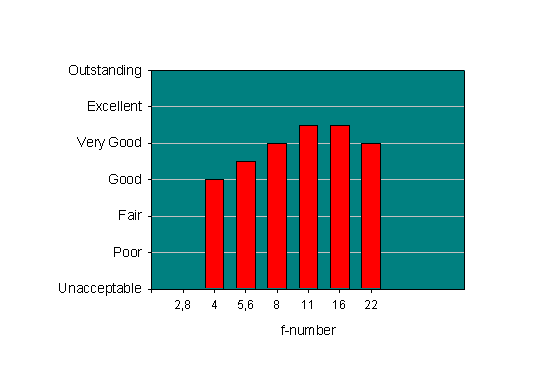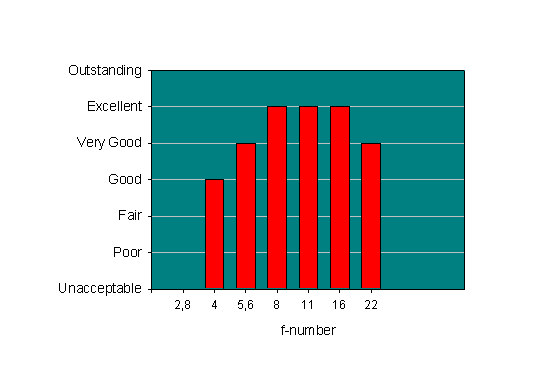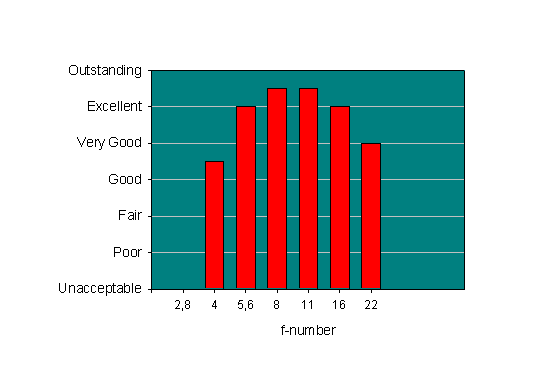| Going Wildly Wide: AFS 12-24 mm
f/4 G ED IF DX Nikkor Reviewed |
|
|
| by Bjørn
Rørslett |
|
3.
Optical Performance
Sharpness is traditionally one of the more
important criteria for photographic lenses. We all want our
lenses to be tack sharp, period end period. Yet sharpness by
itself cannot guarantee anything, and I repeat any thing, in
terms of the ensuing pictorial outcome. The world is flooded with
sharp, dull, and uninspiring images, simply because the
photographer believed his job only was to press the button and
let the camera and lens do the rest. This is a paradox the
handling of which each and every one of us has to balance in our
own chosen manner.
I for one strive for visual impression -
not visual accuracy - in my photography, so spend considerable
time on assigment to circumvent restrictions imparted by a dull
photographic life-likeness. I do care about lens sharpness by all
means, but not as the panacea to solve all photographic problems.
Commitment to the process of creating images will outperform any
MTF plot any time. It's nice to have a sharp lens but better
still to know to which ends it can best be used. Oh well, I
continue to evaluate visual quality by shooting test pictures of
brick walls outside my office, I always have and probably always
shall do assessments this way. At least this procedure provides
me with a guideline as to how the lens performs. I always cross
reference my observations with original slides (or files) from
similar lenses so to have a concistency on my rankings.
I made a number of my traditional
brick-wall test shots with the AFS 12-24 DX, and augmented later
on with a new test series aiming to show how the lens performed
at closer range.
Subjective
Evaluation of the AFS 12-24 mm f/4 DX Nikkor
(for test
setup, and criteria, see here. Remember these values give qualitative -
not quantitative - data, and thus averaging the values is
meaningless)
|
 |
| Performance at 12
mm |
 |
Performance at
18 mm
|
 |
| Performance at 24
mm |
| All tests
obtained with Nikon D1X using NEF raw files processed in
Bibble 3.1a. Lens mounted on a Sachtler ENG 2 CF carbon
tripod with Burzynski head. |
Overall the AFS 12-24 DX lens delivers very
good to excellent image quality across its entire focal range. As
I found with other recent Nikkor zoom lenses, the 12-24 DX
performs better at its long end. In fact, the performance at 24
mm is exemplary and is of a high professional class. I wouldn't
hesitate to put the zoom control towards shorter focal lengths
either.
Image contrast showed just a trace of
internal flare at f/4 and improved at f/5.6-f/11. A slight
softening of contrast occurred from f/16 and was quite visible at
f/22. The decline in performance at smaller f-numbers is inherent
in all lenses and is caused by diffraction. If anything, image
quality of the 12-24 holds up much better than expected when the
lens was stopped well down.
Geometric distortion is of the barrel type
at 24 mm and is visible there, but not occurring to a
detrimentral degree. As you zoom the lens to wider focal lengths,
distortion is reduced and around 18-20 mm you have a lens
suitable even for architecture work. Towards shorter settings,
the geometric distortion, predictably, picks up and a barrel-type
of distortion is plainy visible at 12 mm. There must be
higher-order components in the geometrical rendition too, because
the lines curve much more towards the extreme corners. You should
not consider shooting architecture with this lens set at 12 mm.
Curvature of field was negligible at the
long end of the zooming range and thus images were sharp corner
to corner even at f/4. At 12 mm however, curvature might be a
bigger problem and was readily apparent to give quite soft
corners unless the aperture was moved beyond f/5.6. I expect the
typical usage for a wide-angle zoom lens is for shooting at quite
close range, rather than the infinity-focus type of tests I run
initially. So, in a new test series, shots were made at a
distance of 1 m, and although the field curvature still persisted
for the wide (12 mm) setting, the curvature wasn't further
aggravated. Although the lens clearly not is a flat-field
"macro" design, you can get nice close-ups with it by
keeping the aperture to f/8 or smaller and restrict zooming to
the long end of the range.
The chromatic issue is addressed on the
subsequent page, so get the
salient details there. For now, suffices to say that Nikon has
succeeded in keeping colour fringing at bay for a great deal of
the focal range encompassed by the lens. Not unexpectedly, issues
remain at the very widest settings. Seen as a whole, the lens
design is first class indeed, taking into account the very wide
angles of view covered by this zoom lens. The commendable lack of
vignetting adds to the pleasing impression, too.
The DX concept is intimately linked with
the current small-sized digital sensor of Nikon D1-series and
D100 cameras. Of course, DX lenses apply to the Fuji S1 and S2
cameras as well. However, the 12-24 DX can be mounted on any
camera with an "F" bayonet, and indeed will illuminate
the entire frame of 24 x 36 mm of my F5 when the focusing control
is set between 16 and 24 mm. Any wider than this with a
full-frame camera and you'll get dark corners, very large and
dark by 12 mm in fact. Normally the image circle of any lens
increases when the lens is focused closer, so I thought initially
that I could manage close-ups at 12 mm with the DX lens attached
to my F5. I was proven wrong, however, because the expected
behaviour simply doesn't manifest itself with this lens, on the
contrary, the image circle stays the same or even slightly
decreases towards the near-focus limit. I suspect this results
because the light rays from the exit pupil of the DX lens are
strongly collimated to exit nearly in parallell. Another
indication that the optical design of the 12-24 DX is highly
sophisticated, and a likely explanation as to why the DX gets
away with so little light loss towards the image corners, even at
the huge angle of view at 12 mm.
| Going Wildly Wide: AFS
12-24 mm f/4 G ED IF DX Nikkor Reviewed |
|


